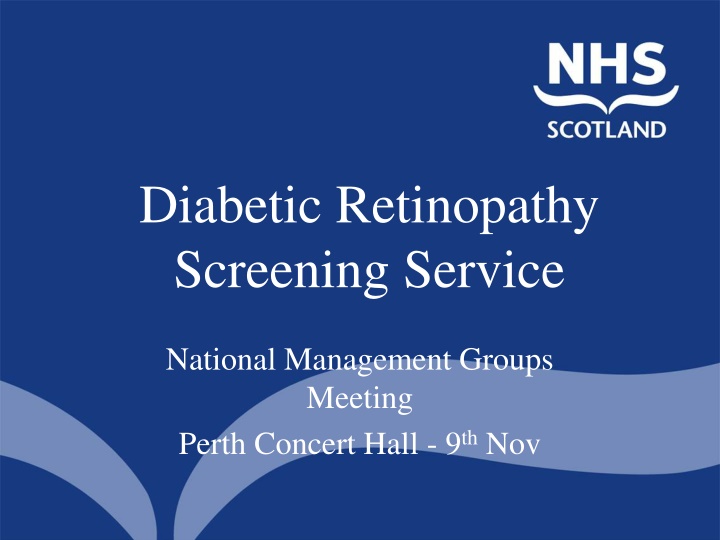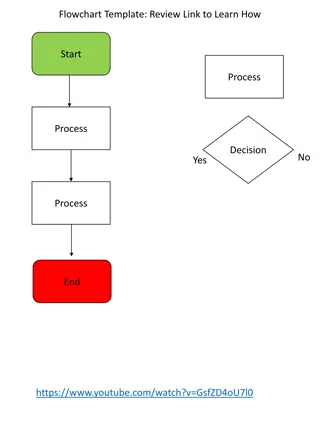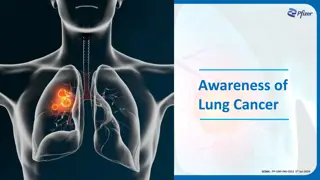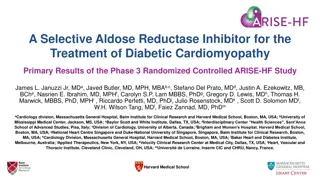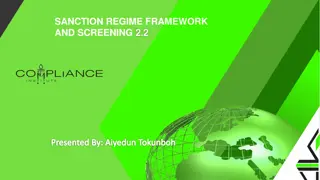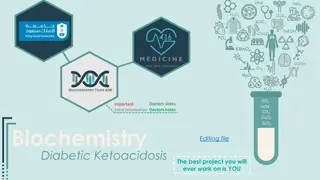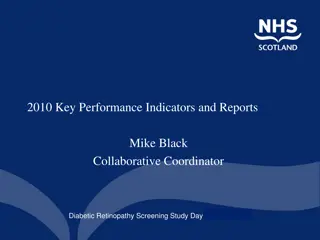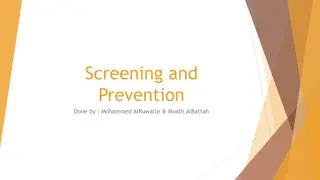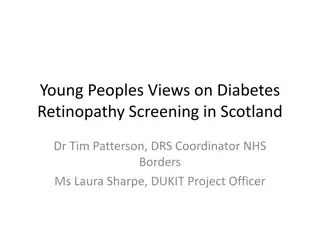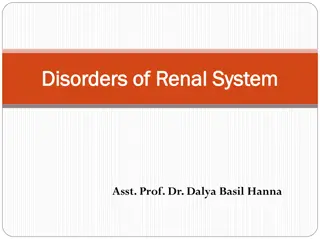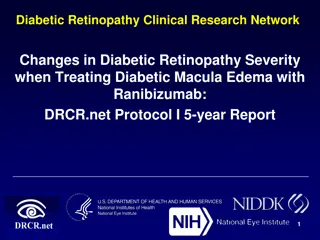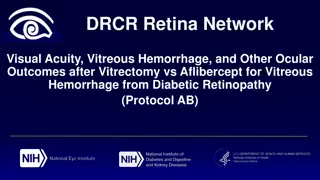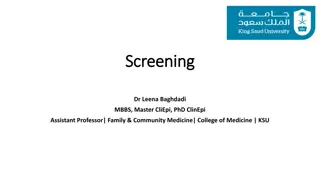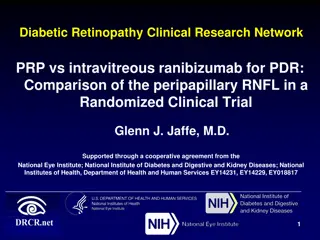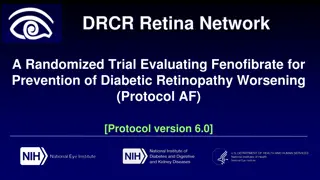Diabetic Retinopathy Screening: National Management Groups Meeting Insights
Key performance indicators (KPIs) from a diabetic retinopathy screening service meeting. Analyze data on uptake rates, population screenings, and referrals. Discover strategies to improve screening invitation rates for better outcomes.
Download Presentation

Please find below an Image/Link to download the presentation.
The content on the website is provided AS IS for your information and personal use only. It may not be sold, licensed, or shared on other websites without obtaining consent from the author.If you encounter any issues during the download, it is possible that the publisher has removed the file from their server.
You are allowed to download the files provided on this website for personal or commercial use, subject to the condition that they are used lawfully. All files are the property of their respective owners.
The content on the website is provided AS IS for your information and personal use only. It may not be sold, licensed, or shared on other websites without obtaining consent from the author.
E N D
Presentation Transcript
Diabetic Retinopathy Screening Service National Management Groups Meeting Perth Concert Hall - 9thNov
Mike Black - DRS Collaborative Coordinator KPIs what they tell us and performance management
Q2 2011 KPI summary Total Diabetic Population aged 12 and over on Soarian (KPI 0) = 258,394 Eligible population (KPI 0) = 223,555 Number of individuals attending screening at least once (KPI 2 -Uptake rate) = 93,303 41.7% Total number of the current eligible population successfully screened (KPI 4) = 84,500 37.8% Not screened or suspended = 139,000 62.2% Referral to Ophthalmology = 2,994 - 3.3%
Q2 2011 KPI summary Total Diabetic Population Q2 2011 = 258,394 Eligible Pop = 223,555 4136 14065 24910 Temp Suspended = 24,910 Permanently Suspended = 14065 Temporarily Unavailable = 4,136 223555
Q2 2011 KPI summary Eligible population as at 30th Sept 2011 = 223,555 - Successfully Screened = 84,500 37.8% - Unscreened = 139,055 62.2%
KPI 2 Uptake rate - Number of individuals attending screening at least once. KPI 2 Percentage Q2 2011 50.00% 45.00% 40% 40.00% 35.00% 30.00% 25.00% 20.00% 15.00% 10.00% 5.00% 0.00%
Ayrshire & Arran 42.60% Borders 44.40% Dumfries and Galloway 46.40% Fife 36.40% Forth Valley 43.50% Grampian 45.10% Greater Glasgow 41.60% Highland 39.50% Lanarkshire 39.60% Lothian 41.20% Orkney 43.50% Shetland 46.90% Tayside 43.30% Western Isles 42.70% National Average - 41.70%
Whats the key to having a good uptake rate ? How about a good invitation rate (Screening Invitation rate - KPI 1)
KPI 1 Screening Invitation rate KPI 1 Percentage Q1 2011 70.00% 60.00% 50% 50.00% 40.00% 30.00% 20.00% 10.00% 0.00%
Ayrshire & Arran 58.00% Borders 56.20% Dumfries and Galloway 53.10% Fife 45.20% Forth Valley 46.20% Grampian 58.30% Greater Glasgow 51.50% Highland 49.10% Lanarkshire 44.60% Lothian 48.20% Orkney 50.30% Shetland 0.20% Tayside 50.10% Western Isles 48.70% Total 50.50%
KPI 1 derived from Percentage (100*INV/EP-API) INV = patients invited at least once EP = eligible population API = patients attending without invitation
API Reporting Start Date Reference Date Reporting interval time Patient Invited Patient Screened INV = 1 API = 0 10th Nov 2010 API = 1 INV = 0
Conclusion to all this is that API rates are wrongly reported and used in KPI 1. Proposal is to use the following equation to show invitation rate Percentage 100 *(API+ INV) / (EP) This would result in the following changes to KPI 1 screening invitation rates
Ayrshire & Arran 58.00% - 61.8% Borders 56.20% - 60.1% Dumfries and Galloway 53.10% - 56.8% Fife 45.20% - 51.0% Forth Valley 46.20% - 51.9% Grampian 58.30% - 62.5% Greater Glasgow 51.50% - 55.4% Highland 49.10% - 53.5% Lanarkshire 44.60% - 51.1% Lothian 48.20% - 53.9% Orkney 50.30% - 55.1% Shetland 0.20% - 47.0% Tayside 50.10% -56.6% Western Isles 48.70% - 55.5% Total 50.50% - 55.1%
Invitation Profiles 100% / 12 months = 8.33% invitation rate per month (in an ideal world). Consider profiling your invitation rates on a monthly or even weekly basis. Your Invitation Profile will depend on many factors related to your area.
12 10 8 6 4 2 0
Dont forget that KPIs can also be used to enhance your invitation targeting by other categories.
Ethnic Minorities Percentage referable each ethnic group. Source: DRS collaborative, Scotland June 2010 10% 9% Percentage referable 8% 5.0%5.3%5.8%6.6%7.1% 7% 6% 5% 3.4% 3.3% 4% 3% 2.2% 2% 1% 0.0% 0% Other Black Pakistani Other Indian Chinese Bangladeshi Other White Other Asian Mixed Origin Black African White Irish White British Overall Scotland White Scottish Ethnic group
Or age group Percentage referable each age group Source: DRS collaborative, Scotland June 2010 10% 9% 8.2% Percentage referrable 8% 7% 5.8% 6% 4.5% 5% 4.2% 2.7% 2.7%3.0%3.4% 3.3% 4% 3% 2% 1% 0.0% 0% 85- 12-14 15-24 25-34 35-44 45-54 55-64 65-74 75-84 Scotland Age Group
and deprivation quintile Percentage referable by quintile of deprivation (Scottish Index of Multiple Deprivation 2009). Source: DRS collaborative, Scotland June 2010 10% 9% 8% Percentage referable 7% 6% 5% 4.1% 3.9% 3.4% 4% 3.2% 3.1% 3% 2% 1% 0% 1 2 4 5 Scotland Quintile of deprivation
To continue to increase performance of the DRS service we will use KPIs to target the use of SMS Email Voice messaging
To summarise KPIs are not perfect and require interpretation. We can do more with them. They are not being used regularly enough by Managers. They are good for reporting success. They are also good for reporting failure !!! Especially when your service is under pressure. They will be important for any future business cases.
